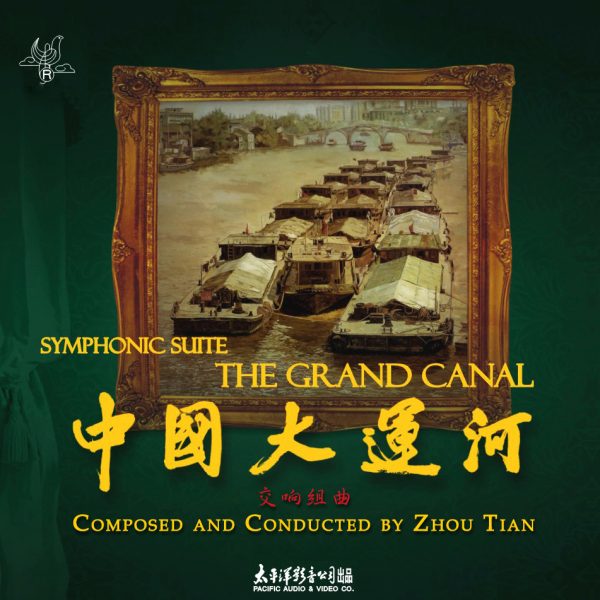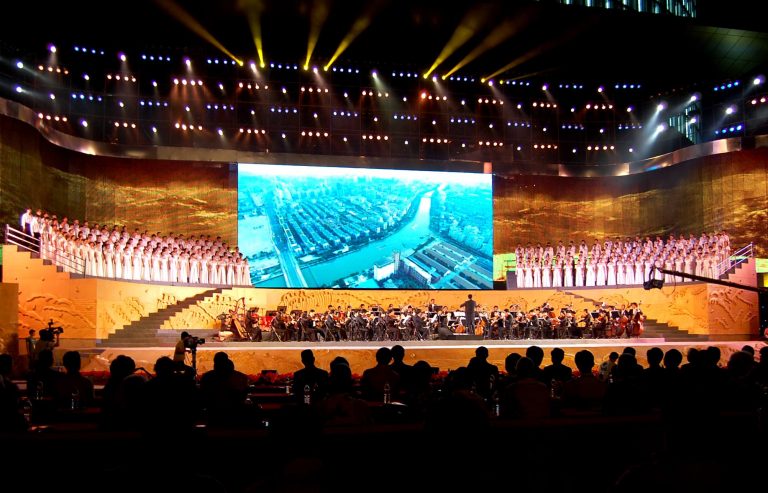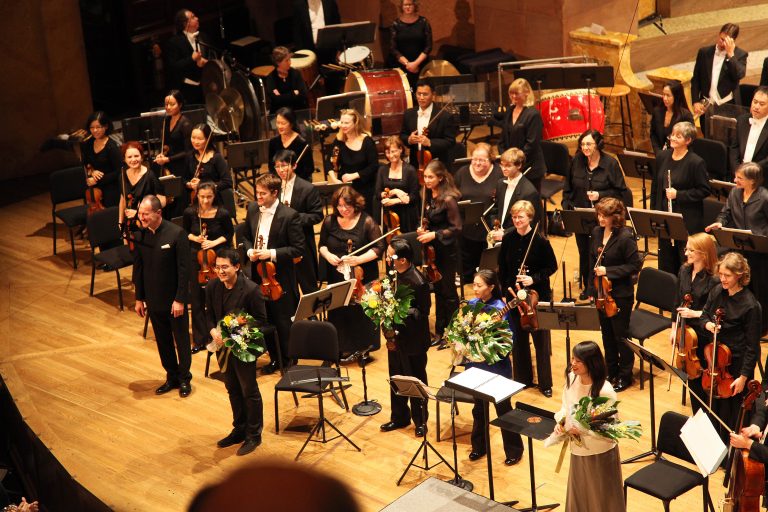
The Grand Canal
For erhu, ruan, Chinese opera singer, (mixed chorus), and orchestra
(2008) | 30/35 minutes
Commissioned by Hangzhou Federation of Literary and Art Circles
SCORING 1 (without choir; 30 minutes)
3333 / 4431 / timp / 4 perc: large traditional Chinese Drum/Taiko Drum, Djembe (Mid, Large), Cymbals, Button Gong, Tamtam, Snare Drum, Bass Drum, Triangle, Vibraphone, Glockenspiel / hp / pno(cel.) / erhu (Chinese violin) / ruan (Chinese lute) / Chinese opera singer (primarily in a narrating role) / str
SCORING 2 (with choir; 35 minutes )
3333 / 4431 / timp / 4 perc: large traditional Chinese Drum/Taiko Drum, Djembe (Mid, Large), Cymbals, Button Gong, Tamtam, Snare Drum, Bass Drum, Triangle, Vibraphone, Glockenspiel / hp / pno(cel.) / erhu (Chinese violin) / ruan (Chinese lute) / Chinese opera singer (primarily in a narrating role) / SATB chorus / str
PREMIERE 11 October 2009, at Hangzhou Grand Theatre, Hangzhou, China, by the Hangzhou Philharmonic Orchestra conducted by Yang Yang
US PREMIERE 7 October 2012, Richardson Auditorium, Princeton, New Jersey, by the Princeton Symphony Orchestra conducted by Rossen Milanov
RECORDING Guangzhou Symphony conducted by Zhou Tian, with Mao Weitao (Chinese opera narration), Ma Lin (Erhu), and Lin Feiya (ruan). Pacific PCD6421
Snapshot
VI. Rhythm (ruan, choir, orchestra). Full version below
In a bid for the Grand Canal of China to become a UNESCO World Heritage Site, the city of Hangzhou commissioned Chinese-American composer Zhou Tian to create a large-scale work celebrating one of China’s great landmarks, with both grand scope and imagination. The 35-minute symphonic suite consists of six movements, each incorporating diverse elements and demonstrating in different ways how the canal has been intertwined with the fabric of Chinese cultural life for more than a millennium.
Listen
I. OPENING (序):A celebratory fanfare. (Choir optional)
II. BEGINNING OF A DREAM (梦源):A bittersweet story of the origin and construction of the Canal, featuring the erhu and a Chinese opera singer narrating in the Yue style. (Choir optional)
III. SPIRIT (河魂):Literary “River Soul,” a symphonic dance
IV(a). LIFE(生命):A hymn to the people who built the Grand Canal. (Choir required. Omitted in the orchestra-only version)
IV(b). MOTHER (母亲): The Grand Canal is known to the Chinese as the “mother river.” This movement features melodies inspired by traditional Chinese tunes, with a Chinese opera singer and the erhu.
V. RHYTHM (水韵):A rondo that begins with three soloists—zhongruan, violin, and cello—and develops into a full orchestral setting, all based on a distinctive Chinese rhythm. (Choir optional)
VI. THE GRAND CANAL (运河):A culmination of the previous material into a grand summary. (Choir optional)
Programme Note
Like the emblematic Great Wall, the Grand Canal of China is one of the oldest and most ambitious man-made structures in both the country and the world. With a history spanning more than 1,400 years, the canal is the longest artificial waterway on the globe, stretching 1,794 kilometers from the northern capital of Beijing all the way south to Hangzhou. Along its course, it crosses five major rivers: the Haitong, Yellow, Huai, Yangtze, and Qiantang.
In a bid for the Grand Canal to become a UNESCO World Heritage Site, the city of Hangzhou commissioned Chinese-American composer Zhou Tian to create a large-scale work celebrating one of China’s great landmarks, with both grand scope and imagination. The 35-minute symphonic suite consists of six movements, each incorporating diverse elements and demonstrating in different ways how the canal has been intertwined with the fabric of Chinese cultural life for more than a millennium.
One of Zhou’s primary interests in composing the work was the opportunity to combine traditional Chinese musical elements related to the culture of the Grand Canal with the sonic resources of a Western symphony orchestra. In the composer’s own words: “Because the Grand Canal was man-made by generations of workers, it is as much about people as it is about its beauty. In this piece, I used many traditional Chinese sounds, such as boatmen’s chants, Erhu, Zhongruan, and Chinese opera singing and narration in the style of Yue, in an attempt to capture the essence of the humanity of the Grand Canal. Overall, I wanted the piece to be a musical journey through many aspects of the Grand Canal. It celebrates its history, cultural significance, and beauty, and hopefully conveys a sense of grandeur, romanticism, and warmth along the way.”
Exploiting all of these resources in a kaleidoscopic fashion, the piece is comprised of six movements, to be performed as follows, with descriptions from the composer.
I Opening (序):A celebratory fanfare.
II The Beginning of a Dream (夢源):A bittersweet story of the origin and construction of the Canal, featuring the erhu and a Chinese opera singer narrating in the Yue style.
III Spirit (河魂):Literary “River Soul,” a symphonic dance.
IV (a) Life (生命):A hymn to the people who built the Grand Canal.
IV (b) Mother (母親):The Grand Canal is known to the Chinese as the “mother river.” This movement features melodies inspired by traditional Chinese tunes, with a Chinese opera singer and the erhu.
V Rhythm (水韻):A rondo that begins with three soloists—zhongruan, violin, and cello—and develops into a full orchestral setting, all based on a distinctive Chinese rhythm.
VI Tomorrow (明天):A culmination of the previous material into a grand summary.


